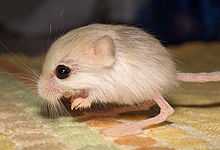Baluchistan pygmy jerboa
| Baluchistan pygmy jerboa Temporal range: Recent | |
|---|---|
 | |
| Conservation status | |
| Scientific classification | |
| Kingdom: | Animalia |
| Phylum: | Chordata |
| Class: | Mammalia |
| Order: | Rodentia |
| Family: | Dipodidae |
| Subfamily: | Cardiocraniinae |
| Genus: | Salpingotulus Pavlinov, 1980 |
| Species: | S. michaelis |
| Binomial name | |
| Salpingotulus michaelis (Fitzgibbon, 1966) | |
The Baluchistan pygmy jerboa, or the dwarf three-toed jerboa, (Salpingotulus michaelis) is a species of rodent in the family Dipodidae. It is the only species in the genus Salpingotulus. Adults average only 4.4 cm (1.7 in) in head and body length, with the tail averaging 8 cm (3.1 in). Adult females weigh 3.75 g (0.132 oz).[2] It is endemic to Pakistan. In the 2010 Guinness World Book of Records, it was listed as tied for the smallest rodent in the world with the African pygmy mouse, but it is even smaller in dimensions and weight than African pygmy mouse.[3]
Distribution
This little rodent species is not found anywhere outside Pakistan. It was first discovered by J. A. Anderson. It is confined to shifting sand dune desert in the Chaghi (Chagai) region of south-western Balochistan.
Habits
This nocturnal jerboa progresses over a dry desert habitat by long hops, balancing itself on its tail while raising food to its mouth. They live in burrows generally excavated under small bushes. They feed on wind blown seeds and succulent leaves of desert adapted vegetation. They undergo a diurnal rhythm of physiological dormancy, when their bodily functions, including respiration and blood circulation, slow down dramatically. This is known as facultative hypothermia and it enables them to survive on a diet of low nutritive value. About 2 to 4 young, blind and naked at birth, are born in the spring and summer months. No more than 2 litters a year are normally produced.
Predators
The natural enemies of this jerboa are the leaf-nosed viper (Eristocophis mcmahoni), the trans-Caspian monitor lizard (Varanus caspius), and the sand cat (Felis margarita).
References
- ↑ Jordan, M., Molur, S. & Nameer, P.O. (2008). Salpingotulus michaelis. In: IUCN 2008. IUCN Red List of Threatened Species. Retrieved 15 March 2009. Database entry includes a brief justification of why this species is of a
- ↑ Field Guide To The Small Mammals of Pakistan, T.J Roberts, OUP. page 162
- ↑ World's Smallest Animals.
- Holden, M. E. and G. G. Musser. 2005. Family Dipodidae. Pp. 871-893 in Mammal Species of the World a Taxonomic and Geographic Reference. D. E. Wilson and D. M. Reeder eds. Johns Hopkins University Press, Baltimore.
